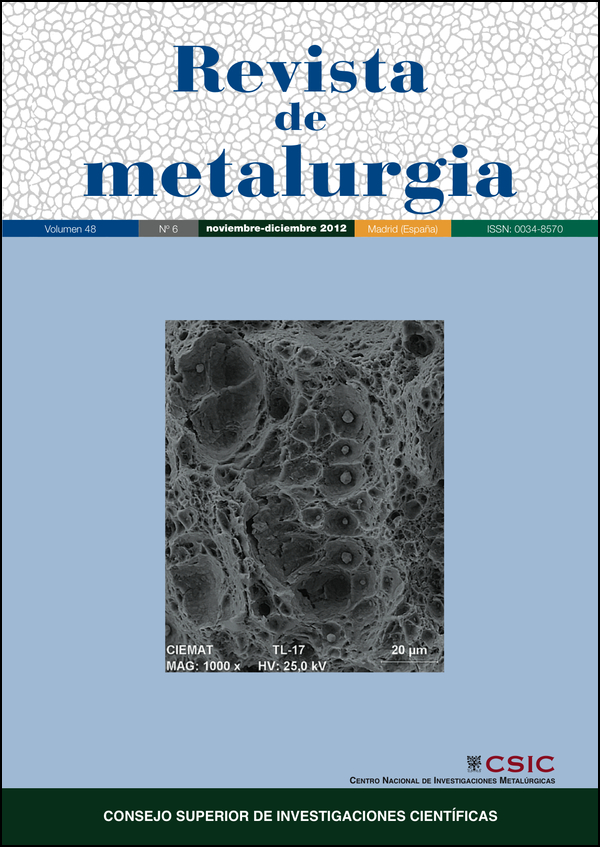Evaluation of structural behaviour and corrosion resistant of austenitic AISI 304 and duplex AISI 2304 stainless steel reinforcements embedded in ordinary Portland cement mortars
DOI:
https://doi.org/10.3989/revmetalm.1203Keywords:
Stainless steel, Reinforcements, Corrosion, Chloride, DuctilityAbstract
The mechanical and structural behaviour of two stainless steels reinforcements, with grades austenitic EN 1.4301 (AISI 304) and duplex EN 1.4362 (AISI 2304) have been studied, and compared with the conventional carbon steel B500SD rebar. The study was conducted at three levels: at rebar level, at section level and at structural element level. The different mechanical properties of stainless steel directly influence the behaviour at section level and structural element level. The study of the corrosion behaviour of the two stainless steels has been performed by electrochemical measurements, monitoring the corrosion potential and the lineal polarization resistance (LPR), of reinforcements embedded in ordinary Portland cement (OPC) mortar specimens contaminated with different amount of chloride over one year time exposure. Both stainless steels specimens embedded in OPC mortar remain in the passive state for all the chloride concentration range studied after one year exposure.
Downloads
References
[1] A. Knudsen y A. Skoysgaard, Concrete Engineering International 3 (2001) 59-62.
[2] S.M. Alvarez, A. Bautista y F. Velasco, Corros. Sci. 53 (2011) 1.748-1.755. http://dx.doi.org/10.1016/j.corsci.2010.09.002
[3] Highways Agency. Design Manual for Roads and Bridge. Vol. 1. Sec. 3. Part 15: BA 84/02 Use of Stainless Steel Reinforcement in Highway Structures, Londres, Inglaterra, 2002.
[4] G. Gedge, Symposium Structural applications of stainless steel in building and architecture, EUROINOX, Septiembre 2000, Bruselas. (www.euro-inox.org).
[5] S. Qian, D. Qu, y G. Coates, Canadian Metallurgical Quarterly 4 (2006) 475-484.
[6] C.M. Abreu, M.J. Cristóbal, M.F. Montemor, X.R. Nóvoa, G. Pena, y M.C. Pérez, Electrochim. Acta 47 (2002) 2.271-2.279.
[7] M.C. García-Alonso, J.A.González, J. Miranda, M.L. Escudero, M.J. Correia, M. Salta y A. Bennani, Cement. Concrete Res. 37 (2007) 1.562-1.569. http://dx.doi.org/10.1016/j.cemconres.2006.09.006
[8] AENOR, UNE-EN 10002-1 Materiales metálicos. Ensayos de tracción. Parte I: Método de ensayo a temperatura ambiente. Madrid, 2002.
[9] AENOR, UNE-EN ISO 15630-1 Aceros para el armado y el pretensado del hormigón. Métodos de ensayo. Parte I: Barras, alambres y alambrón para hormigón armado. Madrid, 2003.
[10] Comisión Permanente Del Hormigón, EHE-08 Instrucción de hormigón estructural. Ministerio de Fomento, Madrid, 2008.
[11] AENOR, UNE-ENV 1992-1-1: EUROCÓDIGO2 Proyecto de estructuras de hormigón. Parte 1-1: Reglas generales y reglas para edificación. Madrid, 1993.
[12] AENOR, EN 1998-1: EUROCÓDIGO 8 Proyecto de estructuras frente a sismo. Parte 1: Reglas generales, acciones sísmicas y reglas para edificación. Asociación Española de Normalización y Certificación, Madrid, 1998.
[13] GEHO-CEB, Código modelo CEB-FIP 1990. Colegio de Ingenieros de Caminos, Canales y Puertos, Madrid, 1995.
[14] A. Cobo, D.M. Bastidas, M.N. González, E. Medina y J.M. Bastidas, Materiales de Construcción 61 (2011) 613-620. http://dx.doi.org/10.3989/mc.2011.57210
[15] CEB, Ductility of reinforced concrete structures, Comité Euro-International du Bêton, Bulletin nº 242, Stuttgart, 1998.
[16] ASTM G61-86, Standard Test Method for Conducting Cyclic Potentiodynamic Polarization Measurements for Localized Corrosion Susceptibility of Iron-, Nickel-, or Cobalt-Based Alloys, P.A., 2009.
[17] M. Stern y A.L. Geary, J. Electrochem. Soc. 104 (1957) 56-63. http://dx.doi.org/10.1149/1.2428496
[18] D.M. Bastidas, J.A. González, S. Feliu, A. Cobo y J.M. Miranda, Corrosion 63 (2007) 1.094-1.100.
[19] H. Castro, C. Rodríguez, F.J. Belzunce y A.F. Canteli, J. Mater. Process. Tech. 143-144 (2003) 134-137. http://dx.doi.org/10.1016/S0924-0136(03)00393-5
[20] E. Real, C. Rodríguez, F.J. Belzunce y A.F. Canteli, Anales de Mecánica de la Fractura 25 (2008) 367-372.
[21] L. Gardner, A. Talja y N.R. Baddoo, Thin Wall. Struct. 44 (2006) 517-528. http://dx.doi.org/10.1016/j.tws.2006.04.014
[22] ASTM C876-99. Standard test method for half-cell potentials of uncoated reinforcing steel in concrete. ASTM, 1999.
[23] M.C.García-Alonso, M.L. Escudero, J.M. Miranda, M.I. Vega, F. Capilla, M.J. Correia, M. Salta, A. Bennani y J.A.González, Cement. Concrete Res. 37 (2007) 1.463-1.471. http://dx.doi.org/10.1016/j.cemconres.2006.09.006
[24] G. Blanco, A. Bautista y H. Takenouti, Cement. Concrete Comp. 28 (2006) 212-219. http://dx.doi.org/10.1016/j.cemconcomp.2006.01.012
[25] M.Criado, D.M. Bastidas, S. Fajardo, A. Fernández-Jiménez y J.M. Bastidas, Cement. Concrete Comp. 33 (2011) 644-652. http://dx.doi.org/10.1016/j.cemconcomp.2011.03.014
[26] S. Fajardo, D.M. Bastidas, M. Criado, M. Romero y J.M. Bastidas, Constr. Build. Mater. 25 (2011) 4.190-4.196. http://dx.doi.org/10.1016/j.conbuildmat.2011.04.056
Downloads
Published
How to Cite
Issue
Section
License
Copyright (c) 2012 Consejo Superior de Investigaciones Científicas (CSIC)

This work is licensed under a Creative Commons Attribution 4.0 International License.
© CSIC. Manuscripts published in both the printed and online versions of this Journal are the property of Consejo Superior de Investigaciones Científicas, and quoting this source is a requirement for any partial or full reproduction.All contents of this electronic edition, except where otherwise noted, are distributed under a “Creative Commons Attribution 4.0 International” (CC BY 4.0) License. You may read here the basic information and the legal text of the license. The indication of the CC BY 4.0 License must be expressly stated in this way when necessary.
Self-archiving in repositories, personal webpages or similar, of any version other than the published by the Editor, is not allowed.


















